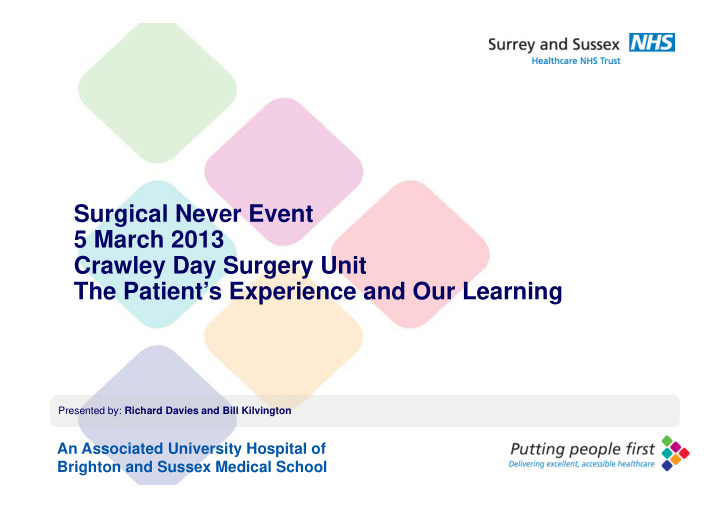



Surgical Never Event 5 March 2013 Crawley Day Surgery Unit The Patient’s Experience and Our Learning Presented by: Richard Davies and Bill Kilvington An Associated University Hospital of An Associated University Hospital of Brighton and Sussex Medical School Brighton and Sussex Medical School 1
The Five Steps to Safer Surgery (more than a checklist) Step one: Briefing – Core members of the team meet before the list commences. Develop a shared mental picture of what is needed/to expect. Step two: Sign in – Before anaesthesia – right patient; right op; right kit; risks Step three: Time out – Before cutting – who’s who in the team; right patient; right op; right kit; risk reduction (VTE, Antibiotic Prophylaxis etc.) Step four: Sign out – Before the patient leaves theatre - all kit present and correct, recovery plan Step five: Debriefing – At the end of the list – what went well or wrong, what would be different next time? An Associated University Hospital of Brighton and Sussex Medical School 2
The event from my perspective I was admitted to the Crawley Day Surgery Unit on the 5 March 2013 the excision of an epididymal cyst An Associated University Hospital of Brighton and Sussex Medical School 3
The event from The Trust’s view Richard Davies admitted to the Crawley Day Surgery Unit on the 5 March 2013 the routine excision of an epididymal cyst. The correct consent was obtained, the site was marked and the WHO surgical checklist was completed appropriately, including the ‘Time Out’ in theatre once Richard was anaesthetised. The surgeon proceeded to perform an unplanned and unnecessary frenuloplasty. The circulating practitioner asked if a the specimen should be sent for histology examination and this alerted the team that they were performing the wrong operation on Richard. The surgeon closed the frenuloplasty wound and proceeded to excise Richard’s epididymal cyst as planned. An Associated University Hospital of Brighton and Sussex Medical School 4
What went wrong? The surgeon lost situational awareness and became focused upon the patient who was to follow into theatre and who was scheduled to have a frenuloplasty, having just spoken to and consented this patient. – Despite having correctly identified Richard in theatre and performing the ‘Time Out’ on the WHO checklist, his mind was on the following procedure during the few minutes he took to scrub-up before commencing Richard’s operation. Contributory factors – The list was running late due to the new procedures performed earlier in the day, and the surgeon did not get sufficient time between the morning and afternoon sessions to take a break – The scrub practitioner was directing a junior member of staff to perform a task and was not watching as the surgeon commenced the procedure – An anaesthetist from another theatre had introduced a degree of stress into the team by giving them the ‘hurry up’ message due to concern about a potential late finish. An Associated University Hospital of Brighton and Sussex Medical School 5
The consequences for me Not knowing what happened or what happens next Emotional impact Physical impact Effect on my job An Associated University Hospital of Brighton and Sussex Medical School 6
Recommendations to prevent this happening again Consideration should be given to reducing the number of patients on a list where a procedure new to the team is to be performed. Members of the clinical team need to have sufficient time for a break during the course of an all-day operating session. Separate briefing sessions should be conducted for the morning and afternoon sessions of an all-day list. This would also allow staff joining the team to be formally inducted into the team. The Time Out should be conducted just prior to commencing the procedure and after the surgeon has scrubbed. Where there is a delay the procedure should be confirmed immediately prior to commencing the procedure. The Scrub Practitioner should focus upon the commencement of the procedure to help ensure the correct procedure is being performed. Likewise, they are required to be particularly focused at the end of the procedure when performing the safety counts. Unnecessary pressure for the team to work faster should be avoided. An Associated University Hospital of Brighton and Sussex Medical School 7
An Associated University Hospital of Brighton and Sussex Medical School 8
The most important lesson of all The very first step following a Serious Incident is to establish who will take responsibility for – communicating with the patient/relatives – ensuring that their immediate needs are being met and questions answered openly and honestly This must commence from day one An Associated University Hospital of Brighton and Sussex Medical School 9
National context 2011/12 Never Events reported to SHAs (SASH events in brackets) – 70 wrong site surgery (0) – 41 wrong implants/prosthesis (0) – 161 retained foreign objects post surgery (1) NHS England – Surgical Services Patient Safety Expert Group – The Surgical Never Events Taskforce A promise to learn a commitment to act - The Berwick Report – Patients and their carers should be present, powerful and involved at all levels of healthcare organisations from wards to the boards of Trusts (Recommendation 3) An Associated University Hospital of Brighton and Sussex Medical School 10
The final word What I have learnt and what I think you should learn from my experience. An Associated University Hospital of Brighton and Sussex Medical School 11
Recommend
More recommend